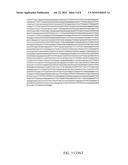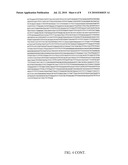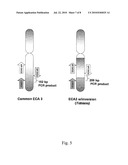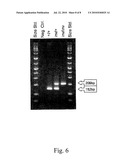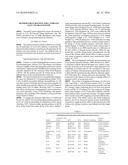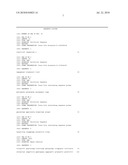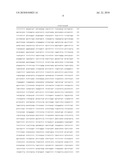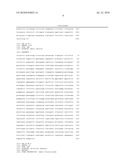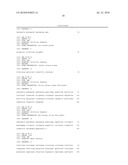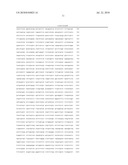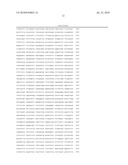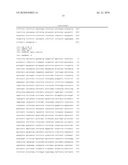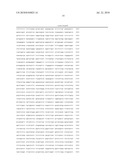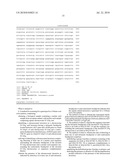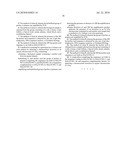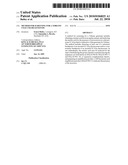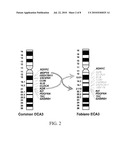Patent application title: METHOD FOR SCREENING FOR A TOBIANO COAT COLOR GENOTYPE
Inventors:
Ernest Bailey (Lexington, KY, US)
Samantha A. Brooks (Newfield, NY, US)
IPC8 Class: AC12Q168FI
USPC Class:
435 6
Class name: Chemistry: molecular biology and microbiology measuring or testing process involving enzymes or micro-organisms; composition or test strip therefore; processes of forming such composition or test strip involving nucleic acid
Publication date: 2010-07-22
Patent application number: 20100184025
Claims:
1. A method for screening for a genotype for a Tobiano coat color pattern,
comprising;obtaining a biological sample containing a nucleic acid sample
from an equine animal, said nucleic acid sample comprising equine
chromosome ECA3q; andidentifying a chromosomal inversion in a chromosome
ECA3q, said inversion having a telomeric breakpoint located between a KIT
gene and a KDR gene in a band ECA3q21 of said chromosome ECA3q and a
centromeric breakpoint located between a ADH1D gene and a UNC5C gene in a
band ECA3q13 of said chromosome ECA3q;said step of identifying a
chromosomal inversion comprising detecting at least one of a nucleic acid
sequence surrounding the telomeric breakpoint of the inverted ECA3q
chromosome and a nucleic acid sequence surrounding the centromeric
breakpoint of the inverted ECA3q chromosome, or sequences complementary
thereto;wherein the presence of the chromosomal inversion as indicated by
detection of at least one of said telomeric breakpoint or said
centromeric breakpoint indicates that the equine animal possesses a
genotype for a Tobiano coat color pattern.
2. The method of claim 1, wherein the centromeric breakpoint is between addresses chr3:41925230-41925231 of EquCab2 and the telomeric breakpoint is between addresses chr3:77663330-77663331 of EquCab2.
3. The method of claim 1, wherein the sequence surrounding the telomeric breakpoint of the inverted ECA3q chromosome is set forth in SEQ ID NO: 14 and the sequence surrounding the centromeric breakpoint of the inverted ECA3q chromosome is set forth in SEQ ID NO: 13.
4. The method of claim 1, wherein the step of detecting at least one of said telomeric breakpoint or said centromeric breakpoint comprises:hybridizing a group of probes or primers consisting of the sequences set forth as SEQ ID NO: 8, SEQ ID NO: 9, and SEQ ID NO: 10 or sequences complementary to SEQ ID NO: 8, SEQ ID NO: 9, and SEQ ID NO: 10 to the nucleic acid;amplifying the hybridized group of probes or primers; anddetecting the presence or absence of a 209 bp amplification product indicative of the presence of the chromosomal inversion.
5. The method of claim 4, wherein the hybridized group of probes or primers are amplified by PCR.
6. The method of claim 1, wherein the biological sample is selected from the group consisting of a cell, a tissue, a hair follicle, a buccal swab, serum, plasma, whole blood, and a combination thereof.
7. The method of claim 4, wherein the presence of the 209 bp nucleic acid sequence is detected by any one of gel electrophoresis, DNA sequence analysis, or Southern blotting.
8. The method of claim 4, wherein the 209 bp nucleic acid sequence is set forth in SEQ ID NO:11.
9. A method for screening for a genotype for a Totiano coat color pattern by detecting a chromosomal inversion in an equine chromosome ECA3q, comprising:obtaining a biological sample containing a nucleic acid from an equine animal;hybridizing to said nucleic acid the group of probes or primers comprising the sequences set forth in SEQ ID NO: 8, SEQ ID NO: 9, and SEQ ID NO: 10, or sequences complementary to SEQ ID NO: 8, SEQ ID NO: 9, and SEQ ID NO: 10;amplifying said hybridized group of probes or primers; anddetecting the presence or absence of a 209 bp amplification product;wherein detection of said 209 bp amplification product indicates the presence of an inversion in an ECA3q chromosome contained in said nucleic acid sample that is predictive of a Tobiano coat color genotype.
10. The method of claim 9, wherein the group of probes or primers are amplified by PCR.
11. The method of claim 9, wherein the presence of the 209 bp nucleic acid sequence is detected by any one of gel electrophoresis, DNA sequence analysis, or Southern blotting.
12. The method of claim 9, wherein the nucleic acid is obtained from a sample selected from the group consisting of a cell, a tissue, a hair follicle, a buccal swab, serum, plasma, whole blood, and a combination thereof.
13. The method of claim 9, wherein the 209 bp nucleic acid sequence is set forth as SEQ ID NO:11.
14. A composition comprising the sequences set forth in the Sequence Listing in SEQ ID NO: 8, SEQ ID NO: 9, and SEQ ID NO: 10, and sequences complementary thereto, for detecting a chromosomal inversion in equine chromosome ECA3q.
Description:
[0001]This utility patent application claims the benefit of priority in
U.S. Provisional Patent Application Ser. No. 60/021,129 filed on Jan. 15,
2008, the entirety of the disclosure of which is incorporated herein by
reference.
TECHNICAL FIELD
[0002]The present invention relates to detection or screening for genotypes for coat color patterns. In particular, the present invention relates to screening for the genotype for the tobiano coat color pattern in horses. The method relies on detection of a chromosome inversion on horse chromosome 3 (ECA3).
BACKGROUND OF THE INVENTION
[0003]Tobiano is a white spotting pattern in horses caused by a dominant gene, Tobiano (TO). The tobiano color pattern of horses is highly valued and selected by many horse owners and breeders. Approximately 350,000 horses carrying TO are currently registered by the American Paint Horse Registry (APHA), but the pattern can also be found among several different horse, pony and draft breeds worldwide.
[0004]TO was previously shown to be genetically linked to the gene for Albumin(AL) (Trommershausen-Smith 1978). Later, an allelic association (linkage disequilibrium or LD) was discovered in which the chromosome possessing the TO allele usually possessed the Albumin (AL)-B and Vitamin D binding factor (GC)-S alleles (Bowling 1987). It is known that certain chromosome rearrangements, such as inversions, can create unusually strong LD by interfering with gamete formation, thus resulting in the formation of conserved haplotype blocks of alleles.
[0005]To explain the unusually high level of LD between the TO, AL and GC loci it was hypothesized that an inversion on ECA3 could be preventing recombination in this region (Bowling 1987). Several similar spotting patterns at the W locus in the mouse have been shown to be due to chromosomal rearrangements near the KIT (v-kit Hardy-Zuckerman 4 feline sarcoma viral oncongene homolog) gene. Two inversions, Rump-white (Stephenson et al., 1994) and Sash (Nagle et al., 1995), and four deletions, Patch, 19h, 57, and Banded (Nagle et al., 1994, Kluppel et al., 1997) occur within the 200 kb upstream of the KIT gene. All have been shown to disrupt the tissue-specificity or temporal expression of KIT during embryogenesis (Nagle et al., 1994; Kluppel et al., 1997; Hough et al., 1998; Berrozpe et al., 1999) rather than a coding sequence. The similarities between Tobiano and this particular group of mouse spotting patterns, previously demonstrated linkage of Tobiano and KIT horse chromosome 3 (ECA3) (Brooks et al., 2002) and the lack of a difference in the KIT cDNA of Tobiano horses (Brooks, 2006) all suggested that a nearby chromosomal rearrangement was the cause of the Tobiano allele. Initial efforts to detect an inversion using cytogenetic methods were unsuccessful (Raudsepp et al., 1999).
[0006]The rearrangement was finally demonstrated by one of the present inventors (Brooks, 2006; Brooks et al., 2007). Cytogenetic evidence showed that there was, indeed, a chromosome inversion on ECA3 near KIT which appeared to be completely associated with TO. No exceptions to the association of Tobiano with the inversion have been found and it is likely that the inversion has this effect by affecting regulation of the gene, KIT, during embryonic development. This conclusion is also based on observation of similar effects of mutation in KIT on mouse hair color.
[0007]The results of mapping several genes are shown in FIG. 1 and Table 1. In the left hand column of FIG. 1, a clear difference can be seen in the distance between KDR (red) and KIT (orange) when comparing the ECA3 from non-spotted horses and the ECA3 bearing TO. The center set of images shows three markers (ALB, Clock, and GABPB1) with different relative orders on each chromosome. The right column shows results from FISH mapping a bacterial artificial chromosome (BAC) 558 which crosses the distal breakpoint (green). On ECA3 from non-spotted horses, hybridization occurred at a single location, while on the chromosome with Tobiano two distinct locations were labeled with the single probe.
TABLE-US-00001 TABLE 1 FISH Markers used in this study in their relative linear order on ECA3. CHORI-241 BAC Sequence Marker Clones HSA ECA Relation to Inversion Source GABRB1 49:M13 4q046.8mb 3q21 Telomeric UCSC Consensus TEC 38:G1 4q047.9mb 3q21 Telomeric UCSC Consensus PDGFRA 23:F11 4qos4.9 3q21 Telomeric UCSC Consensus KIT e21 90:F8 4q055.447mb 3q21 Telomeric Genbank #AY874S43 Intergenic Seq. 102:M1 4q055.558mb 3q21 At Breakpoint UCSC Consensus "558" KDR5'Ue1 129:04 4q055.787mb 3q21 Within UCSC Consensus KDR 127:D23 4q055.7mb 3q21 Within UCSC Consensus Clock 11:A9 4q056.2mb 3q21 Within Murphy et al. 2007 ALB 21:KS 4q074.6mb 3q14. Within Genbank #AY008769 CCNI 99:89 4q078.4mb 3q14.- Within Chowdhary et al. 2003 ENOPH1 69:C10 4q083.7mb 3q13 Within Genbank #cxs03024 WDFY3 44:L24 4q085.9mb 3q13 Within Genbank #CX599384 HSD17B11 105:819 4q088.7mb 3q13 Within Chowdhary et al. 2003 PDLIM5 19:G11 4q095.7mb 3q13 Within UCSC Consensus ADH1C 189:L20 4q100.6mb 3q13 Centromeric Genbank# AF134056
[0008]Since the presence of the tobiano pattern can increase value, horse breeders prefer to use breeding stock which are homozygous for TO, e.g., those which have inherited a copy of the gene from both parents, and will always transmit the gene to their offspring. The cytogenetics test requires freshly collected cells and is expensive to conduct. In place of a cytogenetic test for Tobiano, associative tests have been used to predict homozygosity for Tobiano. As described above, the Tobiano gene was associated in horse populations with particular gene-alleles or SNPs. Specifically, most but not all horses with the Tobiano gene also possessed the B allele for AL and the S allele for GC. Likewise, most but not all horses with the Tobiano gene also possessed the KM1 single nucleotide polymorphism of the gene KIT. Known methods for detecting genetic markers associated with the Tobiana genotype include detection of these nearby genetic markers using biochemical typing or molecular DNA tests. However, biochemical typing methods require freshly obtained biological samples. Furthermore, both biochemical and molecular gene detection methods also produced false positive and false negative reactions because they are associative with the tobiano trait and not actually responsible for the trait (Duffield and Goldie, 1998; Brooks et al., 2002).
[0009]Until present, there have been no precise and cost effective methods to identify all horses homozygous for TO. While the inversion can be detected using cytogenetic studies and fluorescence in situ hybridization (FISH) of DNA probes for genes in the region, this is an expensive and time-consuming procedure. There remains a need in the art for a methods for identifying animals bearing the Tobiano genotype which are effective, rapid, and which further can be performed effectively on stored samples of varying type, to obviate the need for acquiring fresh genetic material.
SUMMARY OF THE INVENTION
[0010]The above-mentioned and other problems are solved by applying the principles and teachings associated with the presently described method for screening for a genotype for a tobiano coat color pattern in an equine animal. In one aspect, the method includes the steps of obtaining a sample containing a nucleic acid from the horse, and analyzing the nucleic acid for the presence of DNA sequence characteristic of an inversion in a chromosome ECA3q. The inversion spans a large region of ECA3, from q13 to q21. One inversion breakpoint lies between the KIT gene and the KDR gene (distal or telomeric breakpoint) while the inversion breakpoint nearest the centromere lies between the ADH1D gene and the UNC5C gene (proximal or centromeric breakpoint). As will be set forth more fully below, the presence of the chromosomal inversion indicates that the equine animal possesses the Tobiano coat color pattern genotype.
[0011]In particular, the chromosomal inversion may be defined by addresses in the equine genome. With reference to the equine genome (EquCab2, available on the University of California Santa Cruz Genome Browser, Genome Bioinformatics Group, Center for Biomolecular Science and Engineering, UCSC) the telomeric breakpoint has been identified as between nucleotides 3:41925230-4192523 1 of EquCab2. The centromeric breakpoint has been identified as between nucleotides 3: 77663330-77663331 of EquCab2. Those breakpoints, along with the 5 kb surrounding those addresses, are set forth in FIGS. 3 and 4 (see SEQ ID NO:13 and SEQ ID NO: 14).
[0012]In one embodiment, the nucleic acid is analyzed for the presence of the distal chromosomal inversion by the steps of hybridizing to the nucleic acid three probes or primers having the sequences set forth as SEQ ID NO:8, SEQ ID NO:9, and SEQ ID NO:10, and deriving an amplification product from those primers. Presence of the chromosomal inversion, and therefore the Tobiano genotype, is indicated by an amplification product having a 209 bp nucleic acid sequence set forth herein as SEQ ID NO:11. An amplification product of 152 bp in length (SEQ ID NO:12) denotes a chromosome lacking an inversion in that region. Different sets of DNA primer sequences may be designed to amplify DNA fragments of the same or different sizes, but the principal accomplishment is the same as long as the primers flank either of the inversion sites found to accompany the Tobiano gene or to occur within the region to detect genetic markers associated with the inversion. The chromosome inversion, or the DNA sequence associated with the inversion, may be detected by any suitable method of DNA analysis, including without limitation, by gel electrophoresis, Southern blotting and specific DNA sequence analysis. Advantageously, the presently described method may be performed on any suitable fresh or stored sample containing a nucleic acid, including without limitation a cell, a tissue, a hair follicle, buccal swab, serum, plasma, and other biological materials derived from an individual.
[0013]These and other embodiments, aspects, advantages, and features of the present invention will be set forth in the description which follows, and in part will become apparent to those of ordinary skill in the art by reference to the following description of the invention and referenced drawings or by practice of the invention. The aspects, advantages, and features of the invention are realized and attained by means of the instrumentalities, procedures, and combinations particularly pointed out in the appended claims. Various patent and non-patent references are discussed herein. Unless otherwise indicated, any such references are incorporated in their entirety into the present disclosure specifically by reference.
BRIEF DESCRIPTION OF THE DRAWINGS
[0014]The accompanying drawings incorporated in and forming a part of the specification, illustrate several aspects of the present invention, and together with the description serve to explain the principles of the invention. In the drawings:
[0015]FIG. 1 compares fluorescence in situ hybridization (FISH) analyses of common and Tobiano ECA3 chromosomes;
[0016]FIG. 2 schematically depicts the positions of various genes located on equine ECA3 in common (non-Tobiano) ECA3 chromosome and in the Tobiano ECA3 chromosome having an inversion;
[0017]FIG. 3 shows the sequences surrounding the proximal (centromeric) breakpoint of a chromosomal inversion in Tobiano ECA3, with primer binding sites and the region of the breakpoint shown in double underlining, and the breakpoint address identified by a vertical line (see SEQ ID NO: 13);
[0018]FIG. 4 shows the sequences surrounding the distal (telomeric) breakpoint of a chromosomal inversion in Tobiano ECA3, with primer binding sites and the region of the breakpoint shown in double underlining, and the breakpoint address identified by a vertical line (see SEQ ID NO: 14);
[0019]FIG. 5 schematically depicts a primer strategy used to detect the inversion in ECA3; and
[0020]FIG. 6 shows a representative result for the present method for detecting a chromosomal inversion in ECA3 by PCR, with amplification products detected by gel electrophoresis and ethidilun bromide staining, with the marked 152 bp product being indicative of the common (non-Tobiano) ECA3 and the 209 bp amplification product being indicative of the ECA3 inversion (Tobiano).
DETAILED DESCRIPTION OF THE ILLUSTRATED EMBODIMENTS
[0021]In the following detailed description of the illustrated embodiments, reference is made to the accompanying drawings that form a part hereof, and in which is shown by way of illustration, specific embodiments in which the invention may be practiced. These embodiments are described in sufficient detail to enable those skilled in the art to practice the invention. Also, it is to be understood that other embodiments may be utilized and that process, reagent, software, and/or other changes may be made without departing from the scope of the present invention.
EXAMPLE 1
[0022]As noted above with respect to genetic markers useful for cytogenetic demonstration of the inversion, one BAC clone (558) mapped to a single location, near KIT, on chromosomes without TO but at two locations, associated with the inversion sites, on chromosomes possessing TO (FIG. 1). This demonstrated that BAC 558 included one of the two sites at which the inversion occurred. Therefore, it was possible to sequence BAC 558 to identify the distal breakpoint for the inversion site.
[0023]The homologous human genome position of the end sequences for BAC 558, shown in FISH experiments to contain the distal breakpoint of the inversion, was determined by searching the database available at the Horse Genome Project web site (Leeb et al., 2006). Within these endpoints regions of high conservation approximately 3-5 kb apart were selected based on the conservation track of the UCSC Genome Browser (Kent 2002). The human sequence for these conserved areas was then used to find a corresponding horse sequence from the trace files submitted to the Entrez Trace Archive using a Discontiguous Megablast (NeBI, 2006). The relative position of these trace files was confirmed by comparing them back to the human genome using the BLAT search on the UCSC Genome Browser. Primers were designed for each individual trace using the Vector NTI software package (Invitrogen, Carlsbad Calif.).
[0024]Primer pairs first optimized to amplify the small product contained in the trace file were then used with the appropriate primer from the next trace to create a product containing the sequence between the two distant trace files. Thirty seven primer pairs were created, and amplification of the intervening sequence was confirmed using DNA from a known TO/TO horse until a primer pair was found where amplification was successful in the non-Tobiano but not the TO/TO horse, indicating that the primer pair had been separated by the inversion. That primer pair is set forth in Table 2.
TABLE-US-00002 TABLE 2 Primers used to screen for the distal ECA3 inversion breakpoint. Trace File Human Address Accession # (Chr4: in Mb) Forward Primer 5'-3' 1250295308 55400840 CTGCCTCCATCAGAGCCTGCA (SED ID NO: 1) Reverse Primer 5'-3' 1378686387 55402968 TGGAGGTGACACAGTGCACTTCACT (SEQ ID NO: 2)
[0025]This set of primers was used to screen animals for the presence of the chromosomal inversion. Absence of a PCR product indicated that the primers were separated by the inversion. This test required use of a positive PCR control fragment, and only detected homozygosity.
[0026]The sequence between the two trace files identified was then determined. The sequence located at the distal breakpoint in a TO/TO horse was determined by genome walking using the APAgene GOLD Genome Walking Kit (BioS&T, Ontario Canada) following the manufacturers directions. Briefly, several rounds of nested PCR were performed using sequence specific primers for the known sequence and universal primers to extend the amplified product in to unknown sequences for which specific primers could not be designed. The primers used were as follows:
TABLE-US-00003 BPFa: (SEQ ID NO: 3) GAT CAG TGT AGA CGT AGT GTG ACA GAG ACC CAG G; BPFb: (SEQ ID NO: 4) GGC AAA CAG AGG GCC AAA TGA TAG ATC AGT GTA GAC; BPFc: (SEQ ID NO: 5) TGT GCT CTA GCA AGG GTG GAG CAT GTT TCA TTA AG.
[0027]The resulting PCR product was directly sequenced using an ABI310 (Applied Biosystems, Foster City, Calif.) following the manufacturers standard protocol for chemistry and conditions. Fifty-two bases of horse sequence beyond the inversion breakpoint were generated (with reference to Genbank Accession #EF442014) and used by Megablast of the Trace Archive to pull trace files containing that sequence NCBI, 2006). The position of these trace sequences relative to the human genome was determined using the BLAT function of the UC8C Genome Browser. The equine sequence encompassing both breakpoint boundaries was determined by assembling these trace files with the ContigExpress function of VectorNTI (see FIGS. 3 and 4). The Genbank accession numbers of the trace files used to create the assembly were:
Centromeric end: 1231203553,1288909375, 1248629699, 1411501757, 1204375030, 1276786693, 1248632879, 1419986588,1286709380,1387598584, 1273872762, 1207301472, 1417784590, 1326270692; and
Telomeric end: 1250295308, 1199900846, 1465783553, 1304105951, 1258859536, 1227749574,1248814034, 1213964577, 1378686387.
[0028]The DNA sequence at the site of the inversion was then identified by sequence walking using DNA from a homozygous (TO/TO) horse as a template (Genbank Accession #EF442014). This sequence, once extended using an alignment of the available equine whole genome sequence trace files from the trace archive at NCBI, was used to design primers that amplify PCR products of unique sizes for each of the inverted and non-inverted chromosomes. The sequences of the assembled contigs for the common (non-Tobiano) and Tobiano sequences are set forth as SEQ ID NO: 6 and SEQ ID NO: 7, respectively.
[0029]For allele identification by PCR, all primers were designed using Vector NTI. A common forward primer was first designed using the sequence just outside of the telomeric end of the inversion. Then a primer specific for the adjoining sequence within the inverted region in the common chromosome and a primer specific for the tobiano inversion were designed to produce two different size PCR products of 209 bp (SEQ ID NO:11) and 152 bp (SEQ ID NO:12), respectively (see FIG. 5). The primer sequences used were as follows:
TABLE-US-00004 ECA3-F: (SEQ ID NO: 8) TGA TAG ATC AGT GTA GAC GTA GTG TGA CAG AGA C; ECA3xR: (SEQ ID NO: 9) AAC AGC TAC TCC CAC TCT AGC ATA GGT TC; ECA3toR: (SEQ ID NO: 10) TTC ACC ACA GAG TAT CCA ATT ATG TCT TTC ACA TAA TGC.
[0030]PCR was preformed using FastStart polyinerase (Roche, Indianapolis Ind.) following in a 10 μL volume using 25 ng extracted DNA or 2 μL of hair lysate prepared using 5-7 hair bulbs according to the method previously published by Locke et al., 2002. Primer concentrations were adjusted as follows to produce two bands of approximately equal intensity: 0.5 uM ECA3-F primer (1 μL of 5 uM dilution), 0.325 μM ECA3xR primer (0.65 μL of 5 μM), 0.175 82 M ECA3toR primer (0.35 μL of 5 μM). All other reagents were used following the manufacturers recommendations. Thermocycling was performed in a PTC-200 thermocycler (MJ Research Inc., Boston, Mass.) with an annealing temperature of 57° C. and 20 s extension time for 35 cycles. Products were visualized by electrophoresis on a 3% agarose gel after staining with ethidium bromide (FIG. 6). Presence of the 152 bp PCR product (SEQ ID NO:12) indicated the horse carried at least one copy of the common chromosomal arrangement. Likewise, presence of the 209 bp product (SEQ ID NO:11) was indicative of the presence of the inversion.
[0031]The chromosomal inversion has been defined by identifying addresses in the equine genome. With reference to the equine genome EquCab2, available on the UCSC Genome Browser, Genome Bioinformatics Group, Center for Biomolecular Science and Engineering, University of California Santa Cruz, the telomeric breakpoint is located between nucleotides chr3:41925230-41925231 of EquCab2. The centromeric breakpoint is located between nucleotides chr3: 77663330-77663331 of EquCab2. Those breakpoints, along with the 5 kb surrounding those addresses, are set forth in FIGS. 3 and 4 (see SEQ ID NO:13 and SEQ ID NO: 14). The 5 kb nucleotides surrounding the centromeric and telomeric breakpoint addresses are set forth in SEQ ID NO:13 and SEQ ID NO:14, respectively, as derived from the publically available ECA3 (EquCab2, UCSC Cenome Browser). These sequences are depicted also in FIGS. 3 and 4, respectively, with the breakpoints indicated by a vertical line and the binding sites for the primers ECA3-F (SEQ ID NO: 8), ECA3xR (SEQ ID NO: 9), and ECA3toR (SEQ ID NO: 10) indicated by underlining and by arrows extending from the respective primer designators.
EXAMPLE 2
[0032]To further evaluate the ability of the PCR method set forth in Example 1 to detect the chromosomal inversion, additional stored samples were obtained for molecular marker studies and DNA sequencing. Previously banked DNA samples from 58 Thoroughbreds (non-tobiano) and 121 tobiano horses of various breeds were selected from samples available at the Immunogenetics and Genomics Laboratory, University of Kentucky. Photographs, pedigree and registrations were examined for all tobiano horses in order to verify presence of the tobiano pattern. Specifically, these horses possessed large white patches that crossed the dorsal midline and had smooth borders. None of the total 179 horses were related as siblings or half-siblings. All tobiano horses had at least one tobiano patterned parent. The breeds of horses evaluated, and the results of the present method for detecting the chromosomal inversion, are provided in Table 3.
TABLE-US-00005 TABLE 3 Breeds of Horses tested for the ECA3 inversion. Breed inv/inv inv/+ +/+ American Miniature Horse 2 3 American Paint Horse 16 53 Arab/Pinto 5 Draft and Draft Cross 2 4 Icelandic Horse 1 Missouri Fox Trotter 2 Pinto 6 Saddlebred 2 Shetland Pony 1 3 Spotted Saddle Horse 3 Tennessee Walking Horse 2 12 Thoroughbred (non-Tobiano) 58 Welsh Cross 2 2 Total 25 96 58 179
[0033]Of 121 horses with the tobiano pattern, all possessed the PCR amplified 209 bp DNA fragment (SEQ ID NO:11) consistent with the inversion. These horses included the following breeds: American Miniature (5), American Paint (69), Arabian (5), draft and draft crosses (6), Icelandic Horse (1), Missouri Fox Trotter (2), Saddlebred (2), Shetland Pony (4), Spotted Saddlehorse (3), Tennessee Walking Horse (14), the Welsh Cross (4) (Table 2). These breeds encompass a wide range of historical breed origins. None of 58 control Thoroughbred horses without the tobiano pattern possessed the inversion, including 3 that carried the KMl marker.
[0034]The tobiano pattern is usually, but not always, associated with the haplotype possessing alleles ALB-B, GC-S and KMI. Therefore, horses with other haplotypes were tested for the presence of the inversion. These haplotypes and their association with the inversion are shown in Table 4. The inversion was present with alleles ALB-A, GC-F and KMO, in addition to the alleles from the most frequent haplotype. Therefore, it is likely that the Tobiano inversion event occurred on a chromosome possessing ALB-B, GC-S and KA1, followed by rare mutations or genetic recombination resulting in new haplotypes possessing TO.
TABLE-US-00006 TABLE 4 Haplotype association of genetic markers for Albumin (ALB), Vitamin D binding Protein (GC), KIT intron 13 SNP (KM) with TO and the ECA3 inversion. Horse ECA3 TO Haplotypes ID# Breed Phenotype AL Gc KM Inversion (AL/Gc/KM) 78 APHA TO A F 1/0 inv/+ A/F/unknown 351 APHA TO B F/S 1/1 inv/inv B/F/1, B/S/1 481 Draft TO B F 1/1 inv/+ B/F/1 cross 480 Welsh TO B S 010 inv/inv B/S/0 cross 479 Welsh TO B S 1/0 inv/inv B/S/1, B/S/0 cross
EXAMPLE 3
[0035]The experiment set forth in Example 1 is repeated using PCR primers designed to amplify the centromeric site of the inversion for those horses with the Tobiano inversion. The PCR and gel electrophoresis conditions are as set forth in Example 1. In this case, the primers would flank the inversion site shown in FIG. 3. Primers ECA3xR (SEQ ID NO:9) and ECA3toR (SEQ ID NO:10) are used, along with a primer ECA3Fc (SEQ ID NO:15; FIG. 3) having a complementary sequence ATGTGCAGTACTCATAATACATTC. Use of this primer combination produces a DNA fragment of approximately 261 basepairs for chromosomes without the inversion and a fragment size of approximately 204 basepairs for chromosomes possessing the inversion.
EXAMPLE 4
[0036]The inversion can be inferred using the technique of restriction fragment length analysis (RFLP). In this approach: 1) DNA fragments are produced including one or both of the chromosome inversion sites; 2) the DNA is digested with restriction enzymes; and 3) the fragments are analyzed by gel electrophoresis for fragment length differences denoting the presence or absence of chromosomes with inversions. Any DNA restriction enzymes recognizing sites on both sides of the inversion as described herein is effective in detecting the presence of fragments characteristic of the presence of the inversion. Experimental techniques for RFLP analysis are as set forth in Molecular Cloning, A Laboratory Manual, Sambrook and Russell, 2001, Chapter 5.
EXAMPLE 5
[0037]Southern blotting (see Chapters 5-6, Sambrook and Russell, 2001) is a method of hybridizing DNA fragments to chromosomal DNA fragments in order to visualize the presence of homologous fragments. In this method, chromosomal DNA is fragmented in a method that produces reproducible cuts, usually with DNA restriction enzyme. The fragments are separated based on length by gel electrophoresis. Subsequently, DNA, called a probe, homologous to DNA from the same region is labeled such that it can be visualized and subsequently hybridized to the chromosomal DNA. Differences in DNA fragment lengths based on the presence or absence of the inversion can be detected by visualizing differences in the size of fragments hybridizing to the probe.
EXAMPLE 6
[0038]As shown in FIGS. 3 and 4, the DNA sequences surrounding the inversions are unique to horses possessing the chromosome inversion. DNA sequencing through the inversion site would effectively demonstrate the presence or absence of the normal or inverted chromosome fragment.
[0039]The presence of a chromosomal rearrangement in ECA3 of animals bearing the Tobiano coat color genotype is now demonstrated, and a method is set forth for detecting the Tobiano coat color genotype in an equine animal, based on detection of the large, paracentric inversion in equine chromosome 3. This inversion described in the foregoing description does not disrupt the coding sequence of any known genes; consequently it is not readily apparent how this may cause the tobiano phenotype. However, without being restricted to any particular theory, the inversion may disrupt conserved non-coding or regulatory regions of the KIT gene, similar to what has been observed in the murine Bump-white (Stephenson et al. 1994) and Sash (Nagle et al. 1995) inversions. Both of these inversions disrupt regulatory elements 5' to the KIT gene and lead to inappropriate temporal and spatial expression in the embryo (Duttlinger et al. 1993; Nagle et al. 1995). Regulatory gene elements that form a loop structure, like enhancers, insulators, and locus control regions, can bind sequences both upstream and downstream of their target gene (Maston et al. 2006). Regulatory elements such as these, encompassing the KIT gene from the intergenic regions upstream to those downstream, could explain the similarities in appearance between the Tobiano phenotype, which is a rearrangement beyond the 3' end of KIT, and the Rump-white and Sash mouse phenotypes, which are both rearrangements of the 5'end of KIT.
[0040]Horses with Tobiano are normal and healthy, suggesting that this chromosome rearrangement is not associated with deleterious health effects. Presence of the inversion among breeds of diverse origins indicates that it predates divergence of these horse and pony breeds. So far there no exceptions have been found for the association of this inversion with the tobiano phenotype, strengthening the hypothesis of homogeneity for the phenotype and genotype. The presently-described PCR-based method for identifying the Tobiano genotype will be useful to breeders interested in finding breeding stock homozygous for tobiano since carriers and Tobiano homozygotes are usually phenotypically indistinguishable. The method can be utilized on any material with DNA, and does not require viable cells. The method thus advantageously does not require freshly obtained genetic material, and even more may be performed on a variety of biological sample types such as hair, with the proviso that the biological sample contains DNA. Hence, more individuals can be subjected to routine screening than would be practical using a more expensive and time-consuming assay such as the FISH method.
[0041]One of ordinary skill in the art will recognize that additional embodiments of the invention are also possible without departing from the teachings herein. This detailed description, and particularly the specific details of the exemplary embodiments, is given primarily for clarity of understanding, and no unnecessary limitations are to be imported, for modifications will become obvious to those skilled in the art upon reading this disclosure and may be made without departing from the spirit or scope of the invention. Relatively apparent modifications, of course, include combining the various features of one or more figures with the features of one or more of other figures.
REFERENCES
[0042]Duffield, DA, Goldie PL (1998) Tobiano Spotting Pattern in Horses: Linkage of To With A1A and Linkage Disequilibrium. Journal of heredity 89: 104-106. [0043]Brooks SA, Lear TL, Adelson DL, Bailey E. (2007) Characterization of the breakpoints of a chromosome inversion associated with the tobiano white spotting pattern in horses. Plant and Animal Genome Conference XV, P599. [0044]Berrozpe, G., Timokhina, I., Yukl, S., Tajima, Y., Ono, M., Zelenetz, A., and Besmer, P., (1 999). The W(sh), W(57), and Ph KIT expression mutations define tissue˜specific control elements located between -23 and -154 kb upstream of KIT. Blood 94, 2658-2666. [0045]Bowling, A., 1987. Equine linkage group II: phase conservation of To with A1B and GeS. J Hered78(4),248-250. [0046]Brooks, S., Terry, R., and Bailey, E., 2002. A PCR-RFLP for KIT associated with tobiano spotting pattern in horses. Anim Genet 33(4), 301-303. [0047]Brooks, S, 2006. Studies of Genetic Variation at the KIT Locus and White Spotting Patterns in the Horse, Ph D. dissertation. University of Kentucky, Lexington Ky. USA. [0048]Chowdhary, B., Raudsepp, T., Kata, S., Goh, G., Millon, L., Allan, V., Piumi, F., Guerin, C., Swinburne, J., Binns, M., et at., 2003. The first-generation whole-genomne radiation hybrid map in the horse identifies conserved segments in human and mouse genomes. Genome Res 13(4), 742-751. [0049]Duttlinger, R., Manova, K., Chu, T., Gyssler, C., Zelenetz, A., Bachvarova, R., and Besmer, P. 1993. W-sash affects positive and negative elements controlling c-kit expression: ectopic c-kit expression at sites of kit-ligand expression affects melanogenesis. Development 118(3), 705-717. [0050]Hough, R., Lengeling, A., Bedian, V., Lo, C. and Bucan, M., (1998). Rump-white inversion in the mouse disrupts dipeptidyl aminopeptidase-like protein 6 and causes dysregulation of KIT expression. Proc Natl Acad Sci 95, 13800-13805. [0051]Karolchik, D., Baertsch, R., Diekhans, M., Furey, T., Hinrichs, A., Lu Y., Roskin, K., Schwartz, M., Sugnet, C., Thomas, D.,et at., 2003. The UCSC Genome Browser Database. Nucleic Acids Res 31(1), 51-54. [0052]Kent, W., 2002. BLAT--The BLAST-Like Alignment Tool, http://genome.ucsc.edulcei-bin/hgB lat?command=start. [0053]Kluppel, M., Nagle, D., Bucan, M., and Bernstein, A., (1997) Long-range genomic rearrangements upstream of KIT dysregulate the developmental pattern of KIT expression in W57 and Wbanded mice and interfere with distinct steps in melanocyte development. Development 124, 65-77. [0054]Lear, T., Brandon, R., Piumi, F., Terry, R., Guerin, G., Thomas, S., and Bailey, E., 2001. Mapping of 31 horse genes in BACs by FISH. Chromosome Res 9(3), 261-262. [0055]Leeb, T., Vogl, C., Zhu, B., de Jong, P., Binns, M., Chowdhary, B., Scharfe, M., Jarek, M., Nordsiek G., Schrader F., and Blocker H., 2006. A human-horse comparative map based on equine BAC end sequences. Genomics 87(6), 772-776. [0056]Locke, M., Penedo, M., Bricker, S., Millon, L., and Murray, J., 2002. Linkage of the grey coat colour locus to microsatellites on horse chromosome 25. Anim Genet 33(5),329-337. [0057]Maston, G., Evans, S., and Green, M., 2006. Transcriptional Regulatory Elements in the Human Genome. Annu Rev Genomics Hum Genet 729-759. [0058]Murphy B., Lear T., Adelson D., and Fitzgerald B., 2007. Chromosomal assignments and sequences for the equine core circadian clock genes. Animal Genetics 38(1), 84-85. [0059]Nagle, D., Martin-DeLeon, P., Hough, R. and Bucan, M., 1994. Structural analysis of chromosomal rearrangements associated with the developmental mutations Ph, W19H, and Rw on mouse chromosome 5. Proc Natl Acad Sci 91,7237-7241. [0060]Nagle D., Kozak C., Mano H., Chapman V., and Bucan M., 1995. Physical mapping of the Tec and Gabrb 1 loci reveals that the Wh mutation on mouse chromosome 5 is associated with an inversion. Hum Mol Genet 4(11),2073-2079. [0061]Raudsepp T., Kijas J., Godard S., Guerin G., Andersson L., and Chowdhary B., 1999. Comparison of horse chromosome 3 with donkey and human chromosomes by cross-species painting and heterologous FISH mapping. Mamm Genome 10(3),277-282. [0062]Sambrook, J. and Russell, D. W., 2001, Molecular Cloning: A Laboratory Manual. 3d Ed. Cold Spring Harbor Press, N.Y. [0063]Stephenson D., Lee K., Nagle D., Yen C., Morrow A., Miller D., Chapman V., and Bucan M., 1994. Mouse rump-white mutation associated with an inversion of chromosome 5. Mamm Genome 5(6), 342-348. [0064]Trommershausen-Smith A., 1978. Linkage of tobiano coat spotting and albumin markers in a pony family. J Hered 69(4), 2 14-216.
Sequence CWU
1
15121DNAArtificial SequenceTrace file Accession # 1250295308 1ctgcctccat
cagagcctgc a
21225DNAArtificial SequenceTrace file Accession # 1378686387 2tggaggtgac
acagtgcact tcact
25334DNAArtificial SequenceTrace file intervening sequence primer
3gatcagtgta gacgtagtgt gacagagacc cagg
34436DNAArtificial SequenceTrace file intervening sequence primer
4ggcaaacaga gggccaaatg atagatcagt gtagac
36535DNAArtificial SequenceTrace file intervening sequence primer
5tgtgctctag caagggtgga gcatgtttca ttaag
3562593DNAEquus caballus 6ctttgctctt gtgttacagg ttcactcaga gaacgcaagc
tttggtgcac cttttcatta 60cactgcctgt aaggcttcca ggaatgagtg cgggcgattt
gctgtgtttt gacatttttt 120tcccctttct gagagctgtc agttgagagg cagtatcctc
ttgtgagaga gtttggtgcc 180ggctgcaaaa ttaaaggcaa gaaataacca caaataagag
agcatgagtg gccagatatc 240tctcaatcct gatatgggct gtggaaggcc atgtgtgttt
atgtcctccc tccagctgga 300gccaagaaga ggcatccgga gtgatggcat ccagaggctg
caggaggcag ggcctgtggg 360ggtataaagg cagtgggatg acagggggcg ttctgctgga
aggtgtacga ggcccttgtt 420gaagccagtg aagtgcactg tgtcacctcc agttttcttg
gggctggact gggctatcca 480ttgaagaaat ggggtggaga acccaggctt agtcattttt
ttcctcccca gtttccgctg 540gttgtgggct ggaatgtgac atgttgtttt ctttactaat
tgggtcataa ttttaaaaag 600ctgatgatct cctttcctta aagtaccagg tctccatatc
aaaccagggg aaactgtgcc 660gtggggttgc tggtgagtct tgctccctag aagccctgta
ggtgatctgt gtcgtcagaa 720gacagaagga ggaatggggg ttccctccct actgctctgg
agaactgtgc tctagcaagg 780gtggagcatg tttcattaag tttcctgggg gcaaacagag
ggccaaatga tagatcagtg 840tagacgtagt gtgacagaga cccaggcaga gctctgcctc
ccggcctgca gcaggggctc 900ccgacttcct tgagtatgtg aatttcctct tcaaactcca
gaatcattca gaacctatgc 960tagagtggga gtagctgttg actgagaaaa cgaaagatga
ttcaaaaaat tattaaatat 1020gcttaaaacc atatttgagt acaacgagag gcactcacaa
ctagaaaaca caactatgta 1080ctggggggct ttggggagaa aaagaagaaa aaaagaagat
tggtaatagt tgttagctta 1140ggtaccaatc ttttaaaaaa aaaagcatat tactcgataa
tcaagttata taatggcata 1200cagttaaaac caaagttgta aagggaccat cacaatcgtt
tctgcaattg gacaaatact 1260caacacacac cccttgtgtc gattcatccc actcttggca
gtgcatcctg tcgatgtgta 1320caatggcagc catgatgcgt tcctccattt cctcaggact
atgagactct tggtgtatgc 1380ccacgagatg tcaatggtgt gatgacctga gctcccgggt
ggctgctgct ccagagttaa 1440gtcaatgttt aaatagaaag ccctacccag tgccctggga
tagattcatg aaagaacttc 1500tggactgctg gaaaatgagg tttcaaagac ttcctgaagc
tgtggggaaa ccccttcagt 1560gtatcctgac actatgttct tcacacacac acacacagag
ttggcatctg tattgatgta 1620tcacaaaagt catgggggat cccttacacg ttcaatcacc
acgtgttggt atttggtgcc 1680ccgtatatgg atgctgtgaa gaatcacatt tttagtgaaa
tgaacacaga cttatcattg 1740aatttgagac aacctgcaaa ggcaacttcg tcttctgtct
gagtctgaaa gcagcagctg 1800aagttttatc gttttacccc atctgcctcc atcagagcct
gcagagggtg caagaaggtt 1860tcatcttcca tcgcttatgg agaaggtgcc agaccatggt
ctgaggaaca caatactctc 1920agccagccct ctttatggac tccttggggc tctgctgaat
gagacaaaaa tgattccgtt 1980ttcttaagac atgtgaaatg taagcacaca caagttggtg
cctactacat gttgctagtc 2040attgagtagt acattttttt cttcaaagcg ttcaattttt
tgaatcatca tgtacatact 2100ggccaaaaac tacaagtaac gcttttgagt taatttgcat
ttttctcatc accaaagcat 2160ctaaacacac cataaaatag ttagacacat atacatcata
ccacagtaat gtggcccttt 2220ataaagtggc atacttttta tagctacctc cgctgatcct
cagaaaaatc ctgtacgata 2280tgcaccatga tccccatttt gcagataagg aaactgggac
tcagagagac agccactgat 2340caaggtcttg cacacagcag attgtggaac taggattccc
ttcaggcctg gaaacccaca 2400gccgctccta caccatgtgg ccttctcaaa taaggaaaaa
cctctgattt cttaaaatag 2460tattgtgcta ttattctctt ttcttggtat ataaaagtaa
aggtttaaat ctggcatttt 2520gtttgttgta ttaggttgaa gtgtgcgaaa ctgctgatac
ttaccatttc tgacctacgt 2580caacctatag ttt
259371520DNAEquus caballus 7ctttgctctt gtgttacagg
ttcactcaga gaacgcaagc tttggtgcac cttttcatta 60cactgcctgt aaggcttcca
ggaatgagtg cgggcgattt gctgtgtttt gacatttttt 120tcccctttct gagagctgtc
agttgagagg cagtatcctc ttgtgagaga gtttggtgcc 180ggctgcaaaa ttaaaggcaa
gaaataacca caaataagag agcatgagtg gccagatatc 240tctcaatcct gatatgggct
gtggaaggcc atgtgtgttt atgtcctccc tccagctgga 300gccaagaaga ggcatccgga
gtgatggcat ccagaggctg caggaggcag ggcctgtggg 360ggtataaagg cagtgggatg
acagggggcg ttctgctgga aggtgtacga ggcccttgtt 420gaagccagtg aagtgcactg
tgtcacctcc agttttcttg gggctggact gggctatcca 480ttgaagaaat ggggtggaga
acccaggctt agtcattttt ttcctcccca gtttccgctg 540gttgtgggct ggaatgtgac
atgttgtttt ctttactaat tgggtcataa ttttaaaaag 600ctgatgatct cctttcctta
aagtaccagg tctccatatc aaaccagggg aaactgtgcc 660gtggggttgc tggtgagtct
tgctccctag aagccctgta ggtgatctgt gtcgtcagaa 720gacagaagga ggaatggggg
ttccctccct actgctctgg agaactgtgc tctagcaagg 780gtggagcatg tttcattaag
tttcctgggg gcaaacagag ggccaaatga tagatcagtg 840tagacgtagt gtgacagaga
cccaggcaga gctctgtgta ctttctgtta tactgctctg 900aataaatatc tgaaatgcct
tgagtgctga atgccaaaga tgattgaaat ccctctgagc 960cgtaaattta aaatgtgttc
tatgtgctga agattttgca ttatgtgaaa gacataattg 1020gatactctgt ggtgaaagac
aggataaatg ttacagaatt ctctgtacct aattcctctc 1080cttttaaaag taaaaataaa
ttgtatcagc ttacatgaaa gtagaaaata aaatataaaa 1140tgatacaaat ccacatctat
ttttttctct ctgattcaag tagcccctaa tttaaacaca 1200cagactagca gctgaatttt
tgttgttatt gttaaagtca gtctagcact tcattgaatg 1260aagaagaatc cgtctgttta
gtgaggaatt aggtcctctg aaacttcaga cagtctgcca 1320aacctcagag attctgacct
tctgctacca ctgccaaatc ataccagagt catttgtcag 1380cagaattttc caaacagggt
tagccagata gatgagcaga cattacacgg ctgctttaaa 1440acctctaatt tcagtggcac
tgaataggct gacaatttcc caagccgact agagagaaac 1500aaggcgttaa aaggatttat
1520834DNAArtificial
SequenceCommon forward primer 8tgatagatca gtgtagacgt agtgtgacag agac
34929DNAArtificial Sequencenon-tobiano primer
9aacagctact cccactctag cataggttc
291039DNAArtificial Sequencetobiano reverse primer 10ttcaccacag
agtatccaat tatgtctttc acataatgc
3911209DNAArtificial Sequence209 bp tobiano unique PCR product
11tgatagatca gtgtagacgt agtgtgacag agacccaggc agagctctgt gtactttctg
60ttatactgct ctgaataaat atctgaaatg ccttgagtgc tgaatgccaa agatgattga
120aatccctctg agccgtaaat ttaaaatgtg ttctatgtgc tgaagatttt gcattatgtg
180aaagacataa ttggatactc tgtggtgaa
20912152DNAArtificial SequenceNon-tobiano 152 bp PCR product 12tgatagatca
gtgtagacgt agtgtgacag agacccaggc agagctctgc ctcccggcct 60gcagcagggg
ctcccgactt ccttgagtat gtgaatttcc tcttcaaact ccagaatcat 120tcagaaccta
tgctagagtg ggagtagctg tt
152135001DNAEquus caballus 13tatatttaaa tactcagagc aattatgaaa ccccacacag
cctcaacaga ccatttaacc 60ttgagcagtg taatttccgg gtgtgtcctg aaaataagtt
ggcaactaat catatataga 120agtaaataaa tgagtcaaaa tatgtctaaa atgaagttat
aagtcaagta agtattgttt 180tgtatctaaa ggaataatgg gtttgttttt agtggaattg
atcacttctt ttttggcagt 240aattaagtag tagaccaact tggaatttta gaatcataaa
agtgaaattc atttttaata 300aattttttta aataaaattc ttagaaaatg gaattcaatc
tacgctgtgg gattttgttt 360ctttggcgtg gcaatggagc tgacattgca gaatgagatg
tggcgaagaa tggctgctct 420ccaacactgt atacaggttt tcttaaatta acggctagat
tgtaaacttc accaaagcag 480agaacacctt ctttttgact gttttatccc tggccctcag
cagagcgctg gcatatagga 540gatcatagct gaaatagctg ctgtttttac cttgaacact
gttctctggt acaacaaaaa 600tgataaaagt catcaagaga ggttagagtt tttacgtaaa
tgttatgcat ttaaaagtat 660aagatatatg tttgtattaa aatagtatct acttttaatc
agtgacatgt gattccttct 720ttaattgaaa agaaagctgt cacattttaa tcaatggtct
atgacagtgt aggaggcgtg 780atagccaata aaacattttt acatggcact tttcctcact
cctttgaaat cggaagcctc 840taaatagata ttctgaacaa aatatatagc ccaagtacga
tccaacttag aaatggaaaa 900aatacagaaa agtttattgt aacatattgg aaatcttaat
atgatgaaac aaaatgagct 960gcccaaattt tggggacgat ggttctgcat ttgcaggtca
ttttggtaat taaaatatgg 1020taaataccag ctgtttctta tgctcttaga ttatctgttc
atgttaccag gatgattttg 1080tgaagccgag tatcagactc catgtcttag caggctcaaa
ggtcaaaatt agaatcttaa 1140attgaagttc gcattaatcc agattgccat ttgcttactt
tttgatagca gtccacctaa 1200actgaaatga gtaatagaga ttttcatgtc tgaatgatat
tcctgccagc accaccaact 1260gttgaatgtt aagtatgaga tttggcaggt gcagagattt
ttagtcacct tcaaaaagca 1320atatgcagac acccaagcca aacagcttat atattaacaa
aatcaacatc caaaccatct 1380gccaatggaa caaacatgtc agtcatcttt ccatttgatt
ggcagggttt ctagaaatga 1440atgattttaa acattatttc tcatcccaaa aaaacacaca
gggaatttta tttacctggt 1500aattgagctg actctgggca aaattatgta gttaaaaacg
tcttcatctt ctccttgctc 1560tttcattgcc tgctcctccg ttaccactgt gtaccctgca
cacccatcct agcacctgtt 1620attaacttat tgactcctgc ctgctgctgt gccaaacagc
gccaggatga gttaatgctt 1680gcatctgatt tatttcctct tagccaacat acgtttttta
ggactctgct tataggcgat 1740tatatttagt aattaaatca ggtaaaccaa ttcttttaaa
ttaaattctt aagttaaaaa 1800tgactgacat ataaaacatg atttttcacc ctctaaaagt
ctttaaagcg taagcataaa 1860tcttttaaac gcttgtttct ctctagtcgg cttgggaaat
tgtcagccta ttcagtgcca 1920ctgaaattag aggttttaag cagccgtgta atgtctgctc
atctatctgg ctaaccctgt 1980ttggaaaatt ctgctgacaa atgactctgg tatgatttgg
cagtggtagc agaaggtcag 2040aatctctgag gtttggcaga ctgtctgaag tttcagagga
cctaattcct cactaaacag 2100acggattctt cttcattcaa tgaagtgcta gactgacttt
aacaataaca acaaaaattc 2160agctgctagt ctgtgtgttt aaattagggg ctacttgaat
cagagagaaa aaaatagatg 2220tggatttgta tcattttata ttttattttc tactttcatg
taagctgata caatttattt 2280ttacttttaa aaggagagga attaggtaca gagaattctg
taacatttat cctgtctttc 2340accacagagt atccaattat gtctttcaca taatgcaaaa
tcttcagcac atagaacaca 2400ttttaaattt acggctcaga gggatttcaa tcatctttgg
cattcagcac tcaaggcatt 2460tcagatattt attcagagca gtataacaga aagtacacag
cagattgtaa tttaaatgct 2520gtactttttg caacatatat ttgcaataaa agcatagaga
atatgtaaaa ataagaatgt 2580attatgagta ctgcacattt tcactacacc ctttgataag
ggaattcttg catactttca 2640tgtaatagac attttctcag tacaactttg tatggaatgc
ataggacaca cacctgatgc 2700tctgttcttc cagccatgtg ggttgtttgt gtccacatta
gggcacttac acctccatgt 2760ggagaccatt tctctatgca gtagagagca aatagaaata
ttttaatatt ggatttattt 2820tttggtatac aaccagacaa tagtgcagaa gatagactgg
agggttaggt gccaagaagt 2880caaattaagg agtcgttgca ataatccatg aggcctgaag
aaggcttcaa ttaagaaaag 2940agagagagcc agagagaatg gagtagggat ttaacatttt
ctaggaagat aaggaaaaga 3000atggcaatcc aggagaaaga atgagacacg gttgccaata
aacgtgatta agaaaaggca 3060tgcagcacga aatgagcaga acttttgcaa aacctatatt
taaggaatta gcaacaataa 3120caaaaaagta gtggctatct tgagaagtta tctcaaggac
aattaaccaa gagttgatga 3180gtttcaggat gttgagaatg aatacagctt tggtcagcgc
aaatgctgaa agtaagctga 3240catttctacc aaaggtcaca gggaagtaga agccctgtgg
tctccgtgtg cacagaaaac 3300tgagagctta tttgaaacaa ataagagcaa gagaaaaaaa
gagccttaaa gaaaaggatt 3360tgatggttga caacaggcat atcagagagt ttgcaaatag
cccatttgga tttggaaatt 3420tggacctctt gcgatgtctg tgagtgtgat tttattagaa
tggtggagat ggaagtcaaa 3480ttttaatcga tttaggtgat gcggattggg gaaattgggg
aaacaagtgt gggcaatttc 3540tgttaaataa tttggtgact aagagaagga gggagacagg
tttcaatttg aagggtataa 3600gagttcagaa aagtacattt gttcattttt aaaaataaat
atggaaggag ggaacctgag 3660tatatttctg tggtgaaagg ttagagagaa gtggaaatag
aatatctaga aaagaccaga 3720gcaaattggt ggtgtaattt aagaggggca aagtgtgcag
gtgaaagtgt gaaccttagg 3780agtcggaagc atggacgcta ggaggtatag acaagaactg
gagcaggagg tggctaggca 3840ctctccccat tggtggcttc tattgcattt atgaagggat
cagagatatg ctgatggtga 3900gacaagtaga aatcttgtag ggaactagag gagagagaat
accagaattg gactactgga 3960cactttgaat gcagtaagca cctgcttaag ataaatactc
ccctcactaa ggaatctctg 4020agaatggtgg ctttttacaa tattgcacct ggtgcttatc
acctcactct ttatgagttt 4080cacaaatatt tagtgagctc agcccatgtg cctagaacta
tatcaaggcc tagtaggttt 4140tataggacaa ggagaagaga tggctcttca aggagcttgg
gcttctgttc tgtcgggtag 4200tattgggcca aggagtagtt tctttcagcc cattttcttc
ttctattgaa cagtatttca 4260ttgtcatatt attccatttg ctgttcatat gtgactgctt
cttggttgca ttgtactttc 4320ctgggcgtgt tatctatatt ttgtgaatgg agaaaggatc
cataatgaca gcattttgtt 4380ctttctccct atgctttcaa atagtgtcag gatgcttatt
tatcagtgct gcctgctgtg 4440agcagctctg tgccaattta gcatcatcag gaacaactac
attaaggtga tggtccctgt 4500gcaagatccg tgagctcgtt ccactaattc atgaaaacat
attcatttat ttttagctaa 4560taaaacgatc ttcaaactgc ttgttcaggc atacatcacc
aaaacatttc ctatgtcttt 4620aatgttttca accttcatta tcttttcact ccactaattt
agaatgtgga gggaaatctc 4680tcaaatttta tgaaattata ctgccatcat ttaacctttg
ctattatgct gatttattta 4740tttattcatt tatttcttta tggcatagga atacataata
aataatgaga atagagttag 4800caacttttaa aaatagaaag tacttactag aataaaaata
gttacctgac agaaagtttt 4860aaaaataatc atttcttcta tttattcact ccacatatgc
taaaaatttt agtggaaact 4920actggtcccg cttccttccc tgcaaagcat ccatttccct
cctttgtcac tgggaaggag 4980tcctagttcc agtgggttga t
5001145001DNAEquus caballus 14ctcacctatg agaccgcttg
gagaagttgg aagggcccaa gggtatatcc aaaaataact 60gacaagcccc tcagccttca
cccaggagtt ccaggattgt cgttccctga ggcaaagctg 120gcaaaggttt ggtggcggca
gctaggagaa agcacctctg gaacatccct cctcggtttg 180aaattctgta agatgagcag
tgtctcagca ggaaggctga gttcgccagc tgataggcag 240gcagctgaca ggccgcagag
ccggggtgca gaggatgact ctgctcggga agtctgctgg 300agctgcagct tgcccaggct
ctctgctctg acactcagca tttgcctcct cttgaaactg 360atctcacctt gttttccacc
tcccctcatc cacacagaag gtaggatttt tttttttttt 420gaggaagatt agccctgagc
taacatctgc tgccaatcct cctctttttg ctgaggaaga 480ctggccctga gctaacattc
atgcccatct tcctctatgt tatatatggg acacctgcca 540cagcatggct tgccaagcag
tgctatgtcc gtacccagga tccgaaccgg caaaccctgg 600gctgccaaag gggaacgtgc
acactgaacc gatgcacctc tgggctggcc cccataagtt 660aggatttttg attttcaaaa
tttttaaaat aaaattatct gttggggctg gccccgtggc 720caagtggtta agttcgcgcg
ctccgctgca ggcgacccag tgtttcgttg gttcgagtcc 780tgggtgcgga catggcactg
ctcatcagac cacgctgagg cagcgtccca catgccacaa 840ctagaagaac ccataacgaa
gaatacacaa ctatgtaccg gggggctttg gggagaaaaa 900ggaaaaaata aaatctttaa
aaaaaaaaat aaaaaataaa aaaataaaat aaaattatct 960gttcatgttt ttaacagcca
tagaaattat taactcctaa ttatagaaac agtggaaaac 1020aaaaccgtac aaagaataaa
ggtgcccaga gacccatagt caccagacaa aggcaaccac 1080gtttatattt tggcctattt
gctatcagtc attaatgtgt gtgtctaggc gcccacatgt 1140gtgaatgcac atattccaac
tttaacacga caaaataaaa caaagtttgc acccaagtta 1200aagccatggt gggtgacact
caacgactca catttgcagt taagaccaag gactaccagt 1260ggccttgcct gggccacgtg
acactgccga gggggccgtt acagttctaa tttacagttt 1320ggctaagcca ggcggcttgg
tgataagcac agcttgttta tttgtctttg atggatgcca 1380ggtggattgt ggtcagacaa
tcttccttca gcagcctcag cactttgcat ccacggagct 1440agcgtgaggc cctcccctga
ggaaaacgca ggtcacacaa tgagcgccca caacaaaggg 1500acggtcacag tggtggcggc
accaaacgag gacaaagaag cgcttgggcg gagaggaaag 1560aggaagaaag cagggagggc
ccaggagacg ccaccaggca ggcaggtggc caggcaagct 1620gaccagcttt gctcttgtgt
tacaggttca ctcagagaac gcaagctttg gtgcaccttt 1680tcattacact gcctgtaagg
cttccaggaa tgagtgcggg cgatttgctg tgttttgaca 1740tttttttccc ctttctgaga
gctgtcagtt gagaggcagt atcctcttgt gagagagttt 1800ggtgccggct gcaaaattaa
aggcaagaaa taaccacaaa taagagagca tgagtggcca 1860gatatctctc aatcctgata
tgggctgtgg aaggccatgt gtgtttatgt cctccctcca 1920gctggagcca agaagaggca
tccggagtga tggcatccag aggctgcagg aggcagggcc 1980tgtgggggta taaaggcagt
gggatgacag ggggcgttct gctggaaggt gtacgaggcc 2040cttgttgaag ccagtgaagt
gcactgtgtc acctccagtt ttcttggggc tggactgggc 2100tatccattga agaaatgggg
tggagaaccc aggcttagtc atttttttcc tccccagttt 2160ccgctggttg tgggctggaa
tgtgacatgt tgttttcttt actaattggg tcataatttt 2220aaaaagctga tgatctcctt
tccttaaagt accaggtctc catatcaaac caggggaaac 2280tgtgccgtgg ggttgctggt
gagtcttgct ccctagaagc cctgtaggtg atctgtgtcg 2340tcagaagaca gaaggaggaa
tgggggttcc ctccctactg ctctggagaa ctgtgctcta 2400gcaagggtgg agcatgtttc
attaagtttc ctgggggcaa acagagggcc aaatgataga 2460tcagtgtaga cgtagtgtga
cagagaccca ggcagagctc tgcctcccgg cctgcagcag 2520gggctcccga cttccttgag
tatgtgaatt tcctcttcaa actccagaat cattcagaac 2580ctatgctaga gtgggagtag
ctgttgactg agaaaacgaa agatgattca aaaaattatt 2640aaatatgctt aaaaccatat
ttgagtacaa cgagaggcac tcacaactag aaaacacaac 2700tatgtactgg ggggctttgg
ggagaaaaag aagaaaaaaa gaagattggt aatagttgtt 2760agcttaggta ccaatctttt
aaaaaaaaag catattactc gataatcaag ttatataatg 2820gcatacagtt aaaaccaaag
ttgtaaaggg accatcacaa tcgtttctgc aattggacaa 2880atactcaaca cacacccctt
gtgtcgattc atcccactct tggcagtgca tcctgtcgat 2940gtgtacaatg gcagccatga
tgcgttcctc catttcctca ggactatgag actcttggtg 3000tatgcccacg agatgtcaat
ggtgtgatga cctgagctcc cgggtggctg ctgctccaga 3060gttaagtcaa tgtttaaata
gaaagcccta cccagtgccc tgggatagat tcatgaaaga 3120acttctggac tgctggaaaa
tgaggtttca aagacttcct gaagctgtgg gaaaaccctt 3180cagtgtatcc tgacactatg
ttcttcacac acacacacac agagttggca tctgtattga 3240tgtatcacaa aagtcatggg
ggatccctta cacgttcaat caccacgtgt tggtatttgg 3300tgccccgtat atggatgctg
tgaagaatca catttttagt gaaatgaaca cagacttatc 3360attgaatttg agacaacctg
caaaggcaac ttcgtcttct gtctgagtct gaaagcagca 3420gctgaagttt tatcgtttta
ccccatctgc ctccatcaga gcctgcagag ggtgcaagaa 3480ggtttcatct tccatcgctt
atggagaagg tgccagacca tggtctgagg aacacaatac 3540tctcagccag ccctctttat
ggactccttg gggctctgct gaatgagaca aaaatgattc 3600cgttttctta agacatgtga
aatgtaagca cacacaagtt ggtgcctact acatgttgct 3660agtcattgag tagtacattt
ttttcttcaa agcgttcaat tttttgaatc atcatgtaca 3720tactggccaa aaactacaag
taacgctttt gagttaattt gcatttttct catcaccaaa 3780gcatctaaac acaccataaa
atagttagac acatatacat cataccacag taatgtggcc 3840ctttataaag tggcatactt
tttatagcta cctccgctga tcctcagaaa aatcctgtac 3900gatatgcacc atgatcccca
ttttgcagat aaggaaactg ggactcagag agacagccac 3960tgatcaaggt cttgcacaca
gcagattgtg gaactaggat tcccttcagg cctggaaacc 4020cacagccgct cctacaccat
gtggccttct caaataagga aaaacctctg atttcttaaa 4080atagtattgt gctattattc
tcttttcttg gtatataaaa gtaaaggttt taaatctgga 4140attttgtttg ttgtattagg
ttgaagtgtg cgaaactgct gatactttac catttctgac 4200cctacggttc aacctaatag
ttttcttctc tgggggaaag aaagaaggaa ggaaggaaag 4260aaggagaaaa tgcaatgcat
gaaaacagag agcaataaaa agatcaaaaa gcacagaagg 4320aggaagaaaa tgagggaagg
aagaaggtat aagaagaaat tagaaattac tagtaaagct 4380ttgtcactct ttctaaactc
tcctgccctt cagtttcttc ccccacagtc ttggctttta 4440ctgtctattg cctttgatca
ggattttctc agtcaccaga ctccttaagt aatcaacaga 4500gaccaactgt atcatattgt
ctttcattct ttatttattt taaacaagga ttgcgcagat 4560ttctagccac caccccgagg
gggtaagagg gaagaaaaga tcgacagaac aaagtcttgc 4620atttattagg accgtctaaa
tacgactttc tcttctcggg ggaaaaacac tggaccaaaa 4680cgaaatgccc tcaatgtaca
aatttgtaga aatgtaaagt tagcatacat tgaagtttca 4740gatgagaaac ttgaccttaa
tgttgaaaga agagagatga gaagacaaaa aaaatgaaag 4800aaaccttttt aaataaataa
ttagcttgga gatgatataa agtgttttct aaatcaatcc 4860attcatagga agaaataaac
acatttgaac aatttgatta acacatgtga ataacaaatg 4920ataaagctag ggagcagctg
aagtcctgcc actgaagact ttaagggata aatgctctca 4980ccccctaatg ctgcctctgg a
50011524DNAArtificial
SequenceCentromeric primer 15atgtgcagta ctcataatac attc
24
User Contributions:
Comment about this patent or add new information about this topic:
| People who visited this patent also read: | |
| Patent application number | Title |
|---|---|
| 20120229407 | Touch Sensitive Device Employing Bending Wave Vibration Sensors That Detect Touch Location And Provide Haptic Feedback |
| 20120229406 | Method and Device for Identifying and Unlocking with Contact Surface Model |
| 20120229405 | IMAGE DISPLAY THAT MOVES PHYSICAL OBJECTS AND CAUSES TACTILE SENSATION |
| 20120229404 | IMAGE DISPLAY THAT MOVES PHYSICAL OBJECTS AND CAUSES TACTILE SENSATION |
| 20120229403 | IMAGE DISPLAY THAT MOVES PHYSICAL OBJECTS AND CAUSES TACTILE SENSATION |

